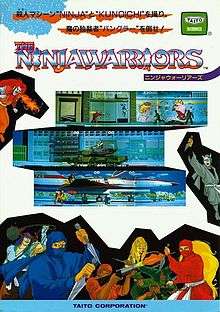The Ninja Warriors (1987 video game)
| The Ninja Warriors | |
|---|---|
 Arcade flyer | |
| Developer(s) | Taito Corporation |
| Publisher(s) | Taito Corporation |
| Director(s) | Masaki Ogata |
| Producer(s) |
Yojiro Suekado Hisao Yunoki |
| Designer(s) |
Hiroshi Tsujino Yukiwo Ishikawa |
| Programmer(s) | Daisuke Sasaki |
| Composer(s) | Hisayoshi Ogura |
| Platform(s) | Arcade, Amiga, Atari ST, ZX Spectrum, C64, Amstrad CPC, TurboGrafx, Mega-CD |
| Release date(s) | 1987 |
| Genre(s) | Beat 'em up |
| Mode(s) | Single-player |
The Ninja Warriors (ニンジャウォーリアーズ) is a side-scrolling beat'em up video game developed and released by Taito in 1987. The original arcade game version used an unusual screen setup that situated one display in between projected images of two other displays, creating the appearance of a triple-wide screen. Versions of the game were subsequently released for a variety of home platforms, including various personal computers, and were mostly well received. A remake known as The Ninja Warriors Again was developed by Natsume and released for the SNES in 1994.
Gameplay
The Ninja Warriors presents side-scrolling hand-to-hand combat. Players take control of Kunoichi (player 1) or Ninja (player 2) and fight wave after wave of Banglar forces across five levels. Button 1 attacks with a short-range kunai slash, while button 2 fires long-range shurikens that are limited in supply.
Plot
The game is based in a dystopian future where Banglar, the President of the United States in 1993, issues martial law on the nation, with the military having total control over the law.[1] A group of anarchist scientists led by Mulk decide that it is time to revolt against the government. Knowing full well that approaching the military themselves could be considered an all out suicide mission, the scientists create two androids that can sustain various forms of damage in order to do the mission for them. The robots, code named "Kunoichi" (red female) and "Ninja" (blue male), are sent by the scientists in order to end Banglar's tyranny once and for all.
Development and release
The game's arcade cabinet is unique due to its three contiguous screens (one screen in the usual place for an arcade game, and two more screens in the cabinet below, reflected by mirrors on either side of the middle screen) which created the effect of a single, "triple-wide" screen, depicting ninjas.[2] The same cabinet was also used for Darius and Darius II and Konami used a similar format for its X-Men arcade release (six players). The music was composed by Hisayoshi Ogura and Taito's in-house band Zuntata. Pony Canyon and Scitron released the two soundtracks for the game in 1988 and 1991,[3][4] while further arrangements were released in 1993[5] and by Zuntata Records and Taito in 1988 and 2009.[6][7]
The game was ported to various personal computers: the Commodore Amiga, Atari ST, Sinclair Spectrum 128K, Commodore 64 and Amstrad CPC. Home console versions of the game were released exclusively in Japan for the NEC PC Engine/TurboGrafx and the Mega-CD. A version is planned for the Arcade Archives series on the PlayStation 4
Reception
| Reception | ||||||||||||||||||||||||||
|---|---|---|---|---|---|---|---|---|---|---|---|---|---|---|---|---|---|---|---|---|---|---|---|---|---|---|
| ||||||||||||||||||||||||||
The Ninja Warriors received mostly positive reviews, especially its 16-bit versions such as the one for the Amiga. In 2010, CraveOnline featured it on the list of top ten ninja games of all time.[18] In 2008, GamesRadar featured Kunoichi as the best assassin in the video game history, stating: "She cut a memorable figure, rocking the huge blonde ponytail and bright-red shozoku. On top of that, she wasn't just a ninja - she was a ninja Terminator. It's hard to imagine a better assassin than that."[19] In 2006, Akiman drew her as his girl of the month for the Japanese magazine GAMAGA.[20] Robert Workman of GameZone included Ninja and Kunoichi on his 2011 list of "best video game ninjas" and stated: "These guys are due for a return – and hopefully a better hyped one than Kage got a few years ago on DS?"[21]
Remake
Natsume developed a 1994 SNES-exclusive remake also known as The Ninja Warriors for a number of its releases, originally titled The Ninja Warriors Again in Japan. It shares the original arcade game but the gameplay has been heavily modified.
References
- 1 2 Crash, Issue 1.90, page 52.
- 1 2 Your Sinclair, Issue 1.90, page 91.
- ↑ "D28B-0001 | The Ninjawarriors -G.S.M. TAITO 1". VGMdb. Retrieved 2013-10-20.
- ↑ "PCCB-00074 | The Ninja Warriors". VGMdb. Retrieved 2013-10-20.
- ↑ "PCCB-00116 | Ninja Warriors Complete Album". VGMdb. Retrieved 2013-10-20.
- ↑ "ZTTL-0024 | Z-REPLICA Vol.1 DADDY MULK THE NINJA WARRIORS". VGMdb. Retrieved 2013-10-20.
- ↑ "ZTTL-9016 | The Ninja Warriors arrange sound tracks". VGMdb. Retrieved 2013-10-20.
- ↑ Computer + Video Games 94 (September 1989).
- 1 2 ACE 27 (December 1989).
- ↑ Amiga Action 5 (February 1990).
- ↑ Amiga Computing Vol 2 No 9 (February 1990).
- ↑ Amiga Format 6 (January 1990).
- ↑ CU Amiga-64 (December 1989).
- ↑ Mega 11 (August 1993), page 48.
- 1 2 3 The Games Machine 26 (January 1990).
- ↑ The Games Machine 28 (March 1990).
- 1 2 Zzap 57 (January 1990).
- ↑ Top 10 Ninja Games Of All Time, CraveOnline, September 18, 2008.
- ↑ The Top 7... Assassins, GamesRadar, 2008-02-05.
- ↑ "Scan of the page in question". Retrieved 2013-10-20.
- ↑ Workman, Robert (2011-11-20). "The Best Of: Video Game Ninjas". GameZone. Retrieved 2014-06-17.
External links
- The Ninja Warriors at the Killer List of Videogames
- The Ninja Warriors at MobyGames
- The Ninja Warriors at World of Spectrum
- The Ninja Warriors - Lost In Translation @ ExoticA
- Hardcore Gaming 101: The Ninja Warriors